We’ve been farming pigs for almost all of recorded human history, which is plenty of time for humans to understand every available part of a pig. Today, professional butchers are masters at identifying all the various cuts of pork, while chefs know exactly how to use them to create amazing dishes. In our post this week, we’re covering both those disciplines in detail as we take you through our butcher’s guide to the various pork cuts.
Now, amongst the cuts of pork we’ll be looking at include:
- Shoulder
- Loin
- Leg
- Belly
- Fillet/Tenderloin
- Rib chop
- Chump chop
- Hock
- Cheek
- Liver
- Crackling
If you’re a professional butcher, we’d always recommend you invest properly in:
Ready? Right then – let’s get started!
1. Pork shoulder
Key information
Pork shoulder is regarded as one of the four primal cuts of pork, the others being loin, leg and belly. It’s also sometimes referred to a pork butt, but actually comes from high on the pig’s shoulder (obviously) – it’s a complex combination of muscles, sinew, connective tissues and fat that extends from spine all the way to the elbow of the front leg. Pork shoulder is known for being full of flavour, especially nearer the head, where you’ll find the sweetest and most succulent meat. It’s also inexpensive, which goes some way towards explaining its popularity with casual and professional cooks alike. It can be minced or diced (for example, using a
compact meat dicer) for slow cooking in stews, or kept on the bone and slow roasted until tender and falling off the bone.
A few suggestions for how to cook pork shoulder
The tenderness of pork shoulder means it’s a favourite for cutting into steaks for grilling or barbecuing, and as one of the singularly best roasting joints, pork shoulder is often a centrepiece for Sunday roasts. If you’re planning on using it for this, we’d recommend cooking it slow and on a low heat, for about 4 to 5 hours at 150
oC. Before you do, it’s worth wrapping it in a double layer of tinfoil before you do so, to really lock in that moisture for tantalising, succulent results. Plus, if you love crackling then the dry skin and layer of fat makes pork shoulder ideal for creating this legendary Sunday favourite.
2. Pork loin
Key information
Another of the four primal cuts of pork, loin is a moderately tough cut with a fair amount of connective tissue. It’s a brilliantly juicy cut that can be sold bone-in or boneless, and a favoured technique for butchers is to bone it and roll it as a roasting joint, or bone it, trim it and cut it into steaks. Another technique for bone-in pork loin is to remove the backbones and trim the ribs to create ‘pork racks’ – sometimes informally known as ‘Frenching’ pork. Similarly, some butchers prefer to tie a two pork racks in a circle to create a roast crown of pork.
Some tips on how to cook pork loin
Like shoulder, pork loin is another classic roasting joint, often paired with apple sauce for a wonderful Sunday roast. It can be cooked in one piece with the bone or deboned, stuffed and rolled up to make roast. Loin chops are ideal for pan roasting and grilling, and a common technique for chefs is to stuff it with herbs, or keep the skin on and crisp it to get crackling. If you’re planning on cooking pork loin yourself, don’t forget to rest the meat before carving, as this will help ensure it stays at its juiciest when you cut it.
3. Pork Leg
Key information
Yes, leg is also amongst the four primal cuts of pork. It’s famously low in fat, so it’s often cured and used to make sliced ham. Otherwise, it’s roasted whole or boned with a boning knife and cut into smaller roasting joints.
A couple of suggestions on how to cook pork loin
When you’re cooking a leg of pork, cooking it on the bone is the best way to ensure it stays moist and juicy throughout. Alternatively if you’re planning on thinly slicing the leg to make steaks, an excellent technique is to flash fry or grill them to prevent them from drying out.
4. Pork belly
Key information
The last of the four primal cuts of pork, the belly is fatty but tender – and absolutely delicious once slow roasted. The fact that it’s so high in fat makes it meltingly tender, and it’s commonly cured (or brined then smoked) to make streaky bacon. In butcher’s shops, pork belly is sold in slices, or boned and rolled to make it ready for roasting. Pork belly goes universally well with crackling, which is where many butchers will find their scoring knife comes in handy – scoring the skin with deep, closely spaced cuts will allow the heat to penetrate the fat, resulting in truly wonderful crackling.
Some tips on how to cook pork belly
Since pork belly is such a robust cut, it’s often paired with Asian spices to give it that extra kick. It can be roasted or stewed (as long as the fat is properly skewed away). Cooking it slowly at a low temperature results in soft meat that melts in the mouth, or alternatively it can be sliced and crisped up in a hot pan – for a crunchier but no less mouth-watering meal.
5. Fillet/tenderloin
Key information
The tenderloin – often fondly referred to as ‘the fillet of pork’, hence the name – is a long, thin muscle on the inside of the ribcage. It’s park of the loin cut, and is well known as the leanest of all the pork meats, ultimately making it a great choice for those trying to go a little more healthy. Each pig has two fillets, and they are highly sought after for their boneless, delicately flavoured qualities.
Quick hints on how to cook pork fillet or tenderloin
Tenderloin is often cut into small round medallions and pan fried, for excellent results that can be used in burgers, salads or stir fries alike. Alternatively, they can be marinated or tenderised and then cooked quickly at high temperatures. Remember, cooking tenderloin for too long will dry it out, so as with all pork loin cuts make sure you rest it for a short while after cooking!
6. Pork rib chop
Key information
Often referred to as spare ribs, these come from the belly side of a pig’s rib cage. Though popular right here in the UK, they’re a particular staple of both American and Chinese cuisine, served in diners and restaurants across both countries – each with their own culinary twists. They’re often grilled or barbecued, and keeping a few together rather than separating them can make a brilliant ‘rib roast’.
Cooking tips for pork rib chop
Pork rib works particularly well with sage and apple, and a whole variety of herbs and spices. Here at Butcher’s Equipment Warehouse, in our opinion it’s best cooked on a pan on the grill, or alternatively on the barbecue – a perfect option now that we’re in summer weather! If you’re going for the latter option, make sure you use a high heat – we like to turn it regularly so it builds up a nice crust.
7. Pork chump chop
Key information
As with lamb, chump means rump – it’s referring to the position of the cut at the rear of the loin. However chump chops are more generous than those from the loin, and are often more thinly sliced. Butchers can sell them either on or off the bone.
How would you cook with a chump chop?
You’ve got plenty of options before you – chump chops are famously versatile and easy to cook, whether you’re frying, grilling or barbecuing them. To offset the fattiness in them, many cooks like to use tango chutney or a similarly tangy dressing when they serve it.
8. Pork hock
Key information
Otherwise known as the pork knuckle, or ham hock, it’s the joint that attaches the pig’s foot to its leg – essentially, the lower shank of the leg just above the foot. Though not the first choice for many diners, it’s a particularly sweet joint that tastes best once it’s been slow cooked.
The golden rule for cooking pork hock
Pork hock is naturally tough piece of meat, full of connective tissue and muscle. This means it needs to be cooked low and slow, to turn it into delicious fork-tender meat – perfect for soups, stews and vegetables.
9. Pork cheek
Key information
One of the most inexpensive cuts of meat, the pork cheek is a fatty, full-flavoured muscle. It’s the slip of meat in the hollow of the cheek, just underneath the animal’s eyes. Relatively lean and very moist, it’s often overlooked by butchers and chefs alike – which is a shame, as it can be used to create some mouth-watering dishes!
Cooking tips for pork cheek
As is generally the case with cheaper cuts of meat, fast cooking isn’t the most viable of options for pork cheek. On the other hand, if it’s minced and/or slow cooked on a low heat for a decently lengthy period of time, the meat breaks down to become beautifully fork-tender. Here at Butcher’s Equipment Warehouse, our personal favourite dish is pork cheek that’s been slow cooked in red wine, and served with mashed potato.
10. Pork crackling
Key information
As we’ve noted a few times above, pork crackling can be obtained from various cuts of meat, including the shoulder, loin and belly. In these cases, it’s once again advisable to score the crackling with a scoring knife, so that the heat is evenly distributed throughout the meat.
What’s involved in cooking crackling?
Ideally, the skin needs to be cooked separately from the meat. Our favourite way to prepare crackling is to trim the skin away from the flesh, salt it and then roast it. Crackling is perhaps best known as a pub nibble, but is also a crowd-pleaser at home gatherings and summer barbecues – making it a fantastic choice for summer weather!
11. Pork liver
Key information
Pork liver is known for being relatively strong in flavour, even compared to other livers (such as those of lamb, calf and chicken). This means that amongst the most common uses for pork liver is in country pâtés, alongside garlic, black pepper and similarly strong, fragrant ingredients.
Cooking suggestions for pork liver
When it comes to pork liver, onions is a frequent accompaniment, and a good plan is to cook it quickly in a hot pan. Alternatively, you can braise it for a gloriously flavourful final dish.
Now that you know all the uses and the best ways to prepare all the various cuts of pork, you’re ready to get started! And here at Butcher’s Equipment Warehouse, we pride ourselves on maintaining a vast range of specialist and general-purpose butcher’s equipment to help you do so. As well as steak knives and boning knives – two essential tools in any butcher’s arsenal – we also stock
bandsaw blades for heavy-duty machinery in professional butcher’s shops. Feel free to explore our site, and if you can’t find what you’re looking for, we’re only a phone call away on
01254 427 761.




